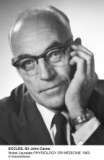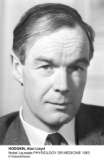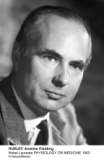


 |
||
|
1963 - Sir John Carew Eccles, Alan Lloyd Hodgkin, Andrew Fielding Huxley
What mechanisms are involved in changing the electrical potential of neurons' membrane? Inserting a microelectrode into the squid giant nerve fibre, Hodgkin and Huxley recorded the electrical potential across the membrane. They experimentally found that the rising phase of the impulse corresponds to a flow of sodium ions into the nerve, replaced by a potassium current outwards in the falling phase. Simultaneously recording cells' potential and current, they calculated the membrane's resistance. Posting these values in a formula embodied in Hodgkin and Huxley's ionic theory of the nerve impulse, a number of known and unknown fundamental attributes of excitability were predicted. Sir John Eccles recorded excitation or inhibition corresponding to ionic currents which push the membrane potential in opposite directions in response to an arriving impulse. Each nerve cell is provided with thousands of synapses, and the total of synaptic processes determines the balance between excitation and inhibition. Elucidating the nature of the unitary electrical events in neurons and synapses strongly advanced our understanding of the nervous action.
|
||



